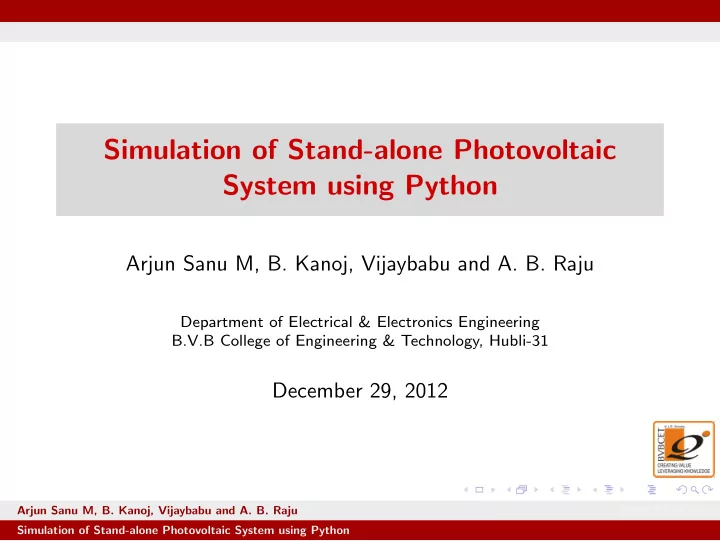

Simulation of Stand-alone Photovoltaic System using Python Arjun Sanu M, B. Kanoj, Vijaybabu and A. B. Raju Department of Electrical & Electronics Engineering B.V.B College of Engineering & Technology, Hubli-31 December 29, 2012 Arjun Sanu M, B. Kanoj, Vijaybabu and A. B. Raju BVBCET Hubli Simulation of Stand-alone Photovoltaic System using Python
System Block Diagram Arjun Sanu M, B. Kanoj, Vijaybabu and A. B. Raju BVBCET Hubli Simulation of Stand-alone Photovoltaic System using Python
Circuit Diagram Arjun Sanu M, B. Kanoj, Vijaybabu and A. B. Raju BVBCET Hubli Simulation of Stand-alone Photovoltaic System using Python
Boost converter Arjun Sanu M, B. Kanoj, Vijaybabu and A. B. Raju BVBCET Hubli Simulation of Stand-alone Photovoltaic System using Python
Case 1: when switch is ON dt = 1 di L [ V in − (1 − S ) V c ] Arjun Sanu M, B. Kanoj, Vijaybabu and A. B. Raju BVBCET Hubli Simulation of Stand-alone Photovoltaic System using Python
dV in = 1 C [(1 − S ) i − V c R ] dt Arjun Sanu M, B. Kanoj, Vijaybabu and A. B. Raju BVBCET Hubli Simulation of Stand-alone Photovoltaic System using Python
Principal Symbols V pv = PV module voltage I pv = PV module currrent I ph = Photo current I rs = Reverse saturation current n s = Number of cells connected in series n p = Number of cells connected in parallel R s = Series Resistance R sh = Shunt Resistance T = Temperature in Kelvin B = Ideality factor of the diode q = Electron charge (1.602 x 10 − 19 C) K = Boltzmann’s constant (1.38 x 10 23 J/K) Arjun Sanu M, B. Kanoj, Vijaybabu and A. B. Raju BVBCET Hubli Simulation of Stand-alone Photovoltaic System using Python
PV Module: Mathematical Model Figure: Typical PV cell V pv = ( n s kTB ) ∗ ln [ n p I ph − I pv + n p I rs ] − R s I pv q I rs Arjun Sanu M, B. Kanoj, Vijaybabu and A. B. Raju BVBCET Hubli Simulation of Stand-alone Photovoltaic System using Python
Electrical Characteristics Symbol Quantity Value P max maximum power 5.0 W V max Voltage at P max 17.2 V I max Current at P max 0.29 A I sc Short circuit current 0.32 A Open circuit voltage 21.0 V V oc Arjun Sanu M, B. Kanoj, Vijaybabu and A. B. Raju BVBCET Hubli Simulation of Stand-alone Photovoltaic System using Python
Results VI characteristics of PV module at different insolations Figure: VI characteristics Arjun Sanu M, B. Kanoj, Vijaybabu and A. B. Raju BVBCET Hubli Simulation of Stand-alone Photovoltaic System using Python
Results Power curves of the PV module at different insolations Figure: Power curve Arjun Sanu M, B. Kanoj, Vijaybabu and A. B. Raju BVBCET Hubli Simulation of Stand-alone Photovoltaic System using Python
Why Python? Python has all the features present in the other simulation softwares. Free and Open Source. Possibility of improving performance comparable to compiled languages. Possibility of developing GUI application. Arjun Sanu M, B. Kanoj, Vijaybabu and A. B. Raju BVBCET Hubli Simulation of Stand-alone Photovoltaic System using Python
flowchart to generate the switching pulses at MPP Arjun Sanu M, B. Kanoj, Vijaybabu and A. B. Raju BVBCET Hubli Simulation of Stand-alone Photovoltaic System using Python
Figure: Plot of Ireference Vs Insolation Arjun Sanu M, B. Kanoj, Vijaybabu and A. B. Raju BVBCET Hubli Simulation of Stand-alone Photovoltaic System using Python
flowchart for system simulation Arjun Sanu M, B. Kanoj, Vijaybabu and A. B. Raju BVBCET Hubli Simulation of Stand-alone Photovoltaic System using Python
Results Arjun Sanu M, B. Kanoj, Vijaybabu and A. B. Raju BVBCET Hubli Simulation of Stand-alone Photovoltaic System using Python
Experimental setup Arjun Sanu M, B. Kanoj, Vijaybabu and A. B. Raju BVBCET Hubli Simulation of Stand-alone Photovoltaic System using Python
Results Dutycycle when R load = 150 ohms Arjun Sanu M, B. Kanoj, Vijaybabu and A. B. Raju BVBCET Hubli Simulation of Stand-alone Photovoltaic System using Python
Conclusion The system simulation has been carried out for one value of insolation & hysterisis band control has been used for generating switching pulses. Further the simulation can be carried out for different insolation levels. MPP tracking algorithms can be implemented. Arjun Sanu M, B. Kanoj, Vijaybabu and A. B. Raju BVBCET Hubli Simulation of Stand-alone Photovoltaic System using Python
References E. Koutroulis, K. Kalaitzakis, and N.C.Voulgaris, Development of a microcontroller-based, photovoltaic maximum power point tracking control system , IEEE Transactions on Power Electronics, vol.16, no.21, pp. 4654, Jan.2001. Arjun Sanu M, B. Kanoj, Vijaybabu and A. B. Raju BVBCET Hubli Simulation of Stand-alone Photovoltaic System using Python
THANK YOU Arjun Sanu M, B. Kanoj, Vijaybabu and A. B. Raju BVBCET Hubli Simulation of Stand-alone Photovoltaic System using Python
Recommend
More recommend